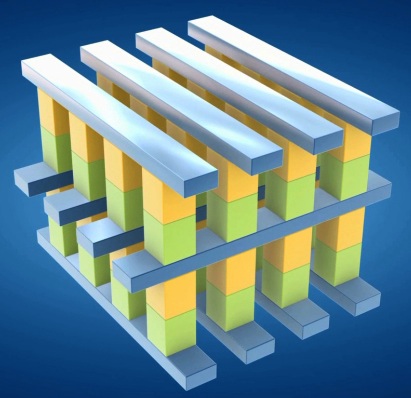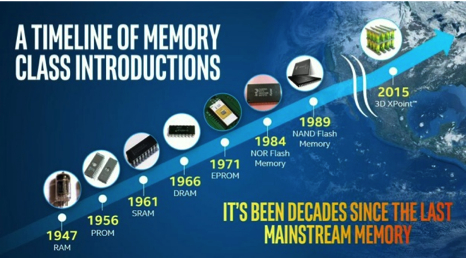Intel and Micron Produce 3D XPoint Non-Volatile Memory …
Initially at 128Gb per die, 1,000 times faster greater endurance than NAND
This is a Press Release edited by StorageNewsletter.com on August 5, 2015 at 3:01 pmIntel Corporation and Micron Technology, Inc. unveiled 3D XPoint technology, a non-volatile memory that has the potential to revolutionize any device, application or service that benefits from fast access to large sets of data.
Now in production, 3D XPoint technology is a breakthrough in memory process technology and the first new memory category since the introduction of NAND flash in 1989.
The explosion of connected devices and digital services is generating massive amounts of new data. To make this data useful, it must be stored and analyzed very quickly, creating challenges for service providers and system builders who must balance cost, power and performance trade-offs when they design memory and storage solutions. 3D XPoint technology combines the performance, density, power, non-volatility and cost advantages of all available memory technologies on the market today. The technology is up to 1,000 times faster and has up to 1,000 times greater endurance (endurance difference based on comparison between 3D XPoint technology and other industry NAND) than NAND, and is 10 times denser than conventional memory.
“For decades, the industry has searched for ways to reduce the lag time between the processor and data to allow much faster analysis,” said Rob Crooke, SVP and GM of Intel’s non-volatile memory solutions group. “This new class of non-volatile memory achieves this goal and brings game-changing performance to memory and storage solutions.”
“One of the most significant hurdles in modern computing is the time it takes the processor to reach data on long-term storage,” said Mark Adams, president, Micron. “This new class of non-volatile memory is a revolutionary technology that allows for quick access to enormous data sets and enables entirely new applications.”
As the digital world quickly grows – from 4.4ZB of digital data created in 2013 to an expected 44ZB by 2020 – 3D XPoint technology can turn this amount of data into valuable information in nanoseconds. For example, retailers may use 3D XPoint technology to more quickly identify fraud detection patterns in financial transactions; healthcare researchers could process and analyze larger data sets in real time, accelerating complex tasks such as genetic analysis and disease tracking.
The performance benefits of 3D XPoint technology could also enhance the PC experience, allowing consumers to enjoy faster interactive social media and collaboration as well as more immersive gaming experiences. The non-volatile nature of the technology also makes it a choice for a variety of low-latency storage applications since data is not erased when the device is powered off.
New Recipe, Architecture for Breakthrough Memory Technology
Following more than a decade of R&D, 3D XPoint technology was built to address the need for non-volatile, high-performance, high-endurance and high-capacity storage and memory at an affordable cost. It ushers in a new class of non-volatile memory that reduces latencies, allowing much more data to be stored close to the processor and accessed at speeds previously impossible for non-volatile storage.
The innovative, transistor-less cross point architecture creates a three-dimensional checkerboard where memory cells sit at the intersection of word lines and bit lines, allowing the cells to be addressed individually. As a result, data can be written and read in small sizes, leading to faster and more efficient R/W processes.
More details about 3D XPoint technology include:
- Cros Point Array Structure – Perpendicular conductors connect 128 billion densely packed memory cells. Each memory cell stores a single bit of data. This compact structure results in high performance and high-density bits.
- Stackable – In addition to the tight cross point array structure, memory cells are stacked in multiple layers. The initial technology stores 128Gb per die across two memory layers. Future generations of this technology can increase the number of memory layers, in addition to traditional lithographic pitch scaling, further improving system capacities.
- Selector – Memory cells are accessed and written or read by varying the amount of voltage sent to each selector. This eliminates the need for transistors, increasing capacity while reducing cost.
- Fast Switching Cell – With a small cell size, fast switching selector, low-latency cross point array and fast write algorithm, the cell is able to switch states faster than any existing non-volatile memory technology today.
3D XPoint technology will sample later this year with select customers, and Intel and Micron are developing individual products based on the technology.
Comments
This comment come from Trendfocus, an analyst form focused on HDDs and SSDs.
Intel and Micron Announce Production of New Memory Technology
3D XPoint offers speed and endurance improvements over NAND,
bridging the gap between storage and memory.
At a press event in San Francisco, CA, Intel and Micron unveiled a joint technology development dubbed 3D XPoint (pronounced crosspoint).
This technology promises a 1,000X speed and endurance improvement over NAND while its 3D stackable structure also offers a 10X density increase over conventional DRAM memory. The crosspoint structure allows for individual addressing of memory cells without requiring structures between the arrays of cells that would prevent dense cell packing.
3D XPoint utilizes a bulk material property change (the material and type of property change were not revealed) of each entire cell, which boh Intel and Micron claim is a key deveopment that will enable scalability at smaller process lithographies.
The companies showed off a finished wafer of 3D XPoint chips produced at a 20nm process node with each chip containing 128Gb of storage. Higher densities can be achieved, by either adding layers or moving to smaller process nodes.
A technology roadmap was not shown, but executives from Intel and Micron indicated that 3D XPoint will scale over time in parallel with 3D NAND, with both technologies coexisting for some time. The speed and endurance advantages over NAND do not bring 3D XPoint up to the speed of DRAM; however, the middle ground that 3D XPoint occupies potentially offers some interesting applications for a higher-performance, non-volatile memory.
In-memory databases on 3D XPoint, for instance, would have speed advantages over NAND-stored databases, and would remain non-volatile, unlike active data stored in DRAM.
Intel and Micron both expect 3D XPoint memory to occupy a price pergigabyte band somewhere between DRAM and NAND, which means that for the foreseeable future, 3D XPoint adoption will be limited to high performance applications that can justify the extra cost.
The fact that no projection was made for a long-term cross-over between 3D XPoint and NAND on a $/GB basis points to the likelihood that 3D XPoint is not necessarily the eventual NAND replacement technology, at least over the next five or more years. Perhaps with additional process developments and technology maturity 3D XPoint could become a replacement for NAND, but Micron's president, Mark Adams, commented that he remains very confident in the ability to execute its long-term 3D NAND roadmap, which will keep NAND around for a substantial amount of time, not requiring a near-to-mid-term replacement technology.
Intel and Micron have begun initial production of 3D XPoint memory at its jointly owned IM Flash Technologies fab in Lehi, UT.
Being a technology announcement, few product-specific details were revealed during the press event. Both Intel and Micron will independently develop products based on the technology that will reach the market in 2016.
Samples of the technology will also ship to select customers later this year.
Read also:
Silicon Motion to offer solutions for 3D XPoint devices
Silicon Motion Technology, a Taiwan-based company engaged in the design and development of NAND flash device controller solutions, will reportedly provide controller chips for SSDs utilizing 3D XPoint memory technology developed jointly by Intel and Micron Technology.














 Subscribe to our free daily newsletter
Subscribe to our free daily newsletter
